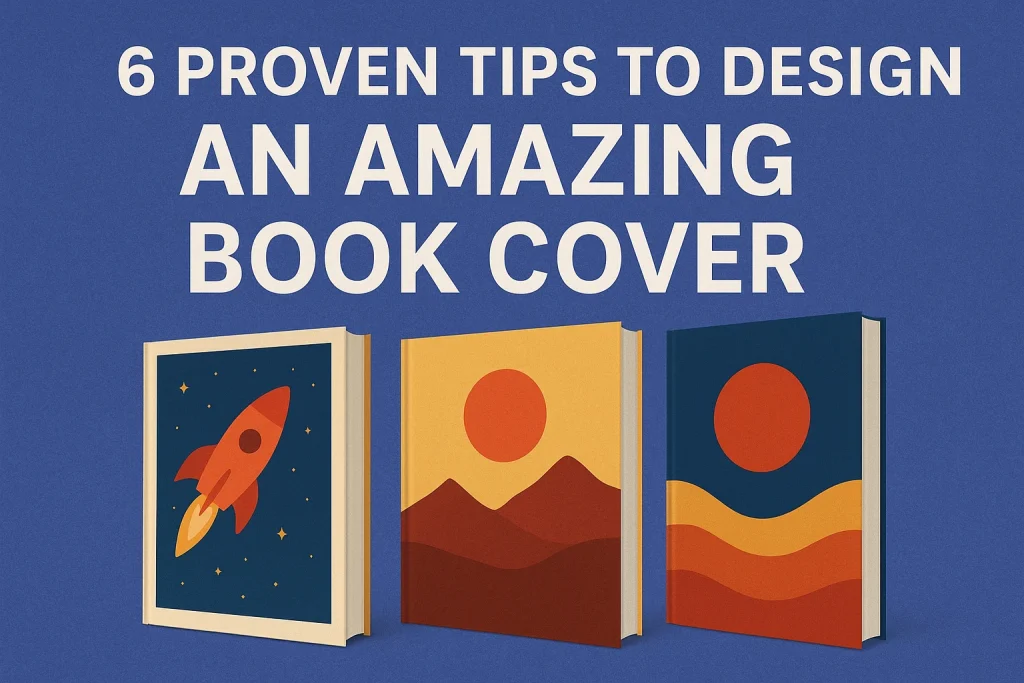You must’ve often come across comments like:
“What a lifeless book cover! I ain’t buying it.”
“They just made the cover go bleh, not worth it!”
“The colors look so bad. Also, I can’t even stand the font!”
These comments are no joke; they come from very real readers who just don’t like the first impression of the book. While readers may check the description and look at the pricing, the cover itself is the very first thing that forces the reader to make a purchase. Now, be it the paperback or eBook, the cover needs to stand out. It is the most important thing that authors have at their disposal while conveying their content, tone, and even the message reflection.
But what does it take to design a book cover? In this blog, we will discuss a few proven tips and tricks that will keep your eBook cover game stronger while doubling the sales.
Table of Contents
ToggleImportance of Book Covers in 2025 & Beyond!

A book cover is often the very first thing that your readers will look at. It serves as a silent salesperson of your book and differentiates it from others in a crowded marketplace.
As per data collected, book covers are a key factor in driving sales, with many books that are usually bought just on the basis of their designs. Furthermore, the book covers help in achieving the following goals:
- Marketing tool for first impressions
- Communication of the genre of your book
- Building emotional connection through imagery
- Setting readers’ expectations and building author credibility
- Leaving a lasting impression even before purchase

Book Cover Classification
Since the word ‘book cover’ is an umbrella term, we have designed this table below to help you understand it all a lot better.
| Mood / Atmosphere | Genre | Design Approach |
| Mysterious → dark tones, shadows, symbols | Mystery / Thriller → crime, suspense, secrets | Illustrated → hand-drawn or painted art |
| Romantic → soft colors, dreamy, emotional | Romance → love, relationships, passion | Photographic → real photos of people/places |
| Adventurous → bold, dynamic, energetic | Fantasy → magic, mythical worlds | Typography-led → title & fonts as focus |
| Whimsical → playful, colorful, quirky | Science Fiction → futuristic, tech, space | Collage / Mixed Media → layered textures, cutouts |
| Dark / Gothic → eerie, moody, dramatic | Horror → scary, unsettling | Abstract → shapes, patterns, moods without clear images |
| Minimalist → simple, clean, lots of space | Nonfiction → factual, clean, direct | — |
| Epic / Grand → sweeping, powerful, cinematic | Memoir / Biography → portraits, personal life | — |
With this table by your side, you can make multiple mixes and matches. For instance;
- A mysterious thriller with minimal typographic design
- A whimsical children’s fantasy with illustrations
- An epic sci-fi with futuristic patterns
6 Proven Tips to Design an Amazing Book Cover

To design a book cover, you need a solid plan in mind, and it can be overwhelming. And being a writer, you may end up making a wrong decision instead of choosing the right one.
This is where you need help from professional designers. They can guide you best and can provide you with an outstanding cover as well. But don’t worry, you won’t always have to pay if you can’t afford it. Here are a few tested tips to help you design your paperback or eBook cover.
1. Take Inspiration from Covers of Your Genre
First up, before designing a book cover, take inspiration from the covers of books in the same genre. For example, if you are writing a novel like a suspense or thriller, your book cover should portray some mysterious vibes. If it is a rom-com, it should have romantic couple poses. But this is a generic idea, so ensure to take inspiration from other books of the same genre.
Expert Tip:
Check the top books in your genre on Amazon or Indigo notice the colors, fonts, and images that stand out. These cues can spark ideas and show readers your book belongs.
2. Pick the Right Design Tools
To design a good book cover, you need the right tools. Remember, Leonardo Da Vinci didn’t make Mona Lisa with crayons! If you are unsure of the right toolkit, you can consider taking the help of custom eBook cover design services. But if you are confident in your design abilities, you can use the following tools.
| Professional-grade Software | Consumer Software |
| Adobe Suite | Canva |
| QuarkXPress | Adobe Spark |
| Affinity Suite | GIMP |
| Procreate & Adobe Fresco | Figma |
3. Craft an Amazing Concept
Once you have found your way of either going with a professional one or a consumer one, now is your time to channel your energy into creating some powerful concepts. You can start by throwing all the ideas onto the wall and see what sticks better. While creating concepts, ensure to capture the following in the design;
- Book’s final message
- Your tone
- Characters or shadows
- Locations and period
- Icons (if needed)

4. Choose Imagery and Design Style
Let’s move on to the next step, which is choosing the imagery and design style. Generally, there are four typical classes: stock images, type-led, illustrated covers, and photographs. With these traditional types, you can make a mix and match and show up with a powerful design concept and style.
Expert Tip:
If you need assistance, you can contact a professional book cover designer who can guide you on what looks best with your book.
5. Develop the Design
So, once the concept is finalized, you have chosen your imagery and design style, it’s time to move forward with design development. This is one of the most creative yet frustrating parts of the book cover because it solely depends on multiple experiments mixed with your story and book. While doing so, ensure to focus on the details that matter the most for your concept.
Expert Tip:
Try out different color schemes and make your design fit in or pop out to create an impact on the reader.
6. Refine the Design and Adapt to Other Formats
Lastly, refine your design and make it super readable for all the formats (available across the globe!). Don’t leave your reader dangling that looks creepy or boring while contradicting their eyes. Once everything is final, test your cover concept via A/B testing and social media polls.
Expert Tip:
Gather the data and go ahead when your mind and heart are settled altogether on the final design.

The Bottom Line!
Designing a book cover can be hectic, but with the right tools, concept, and creativity, it is one of the most fun parts of bringing your book to life. With the tips mentioned above, you can easily craft an amazing book cover on your own that will surely grab the eyes of your readers.
And, if you are searching for proper guidance, you can contact custom eBook cover design services like Ghostwriting Assistance. Our design experts are just a ring away!
Frequently Asked Questions
1. Why does an eBook cover matter so much?
Think of your cover as the handshake before someone opens your book. If it feels inviting and professional, readers are far more likely to give your content a chance.
2. What makes a cover instantly appealing?
It’s usually a mix of clean fonts, striking visuals, and a layout that feels balanced. A good cover should grab attention while hinting at the story inside.
3. Do I really need fancy design software?
Not at all. Tools like Canva or Figma make it easy for beginners, while Adobe Suite or Affinity are great if you want more control and features. It’s about what feels right for you.
4. How do I pick the right colors and fonts?
Colors should set the mood: dark tones for mystery, bright ones for romance or adventure. When it comes to fonts, keep it simple: one main style and maybe a secondary for accents.
5. Should I design it myself or hire someone?
If you enjoy being creative and have time to experiment, DIY can work well. But if you want a polished, market-ready look without the stress, a professional designer is worth the consideration.

